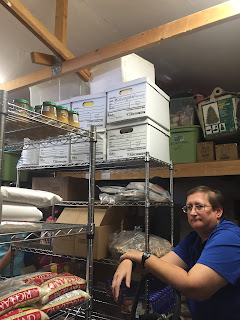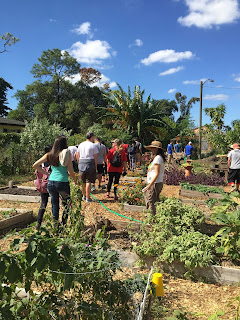Corkscrew Swamp Sanctuary was one of the best field trips we took this year. Not only was is incredibly beautiful, but we saw so much wildlife. I so enjoyed the diverse ecosystems that all existed together in this sanctuary (figure A). There were prairie lands (figures B and C) and wetlands (figures D and E) for land and freshwater animals to inhabit. A wooden walkway winds itself through the sanctuary, making it safe for explorers while they observe nature, and along the walkway there are benches so that guests can take a break while they walk through the large preservation (figure F). The preserve has many walkways that lead to different areas, and in order to protect the animals that breed there some walkways are shut down temporarily. Corkscrew wants to ensure that the safety of its non-human inhabitants it their first priority.
Figure A: Map of Corkscrew Swamp Sanctuary
Figure B: Southwest Fl Prairie Lands
Figure C: Overgrown Prairie Bush
Figure D: Wetlands
Figure E: Swamp/ Wetlands
Figure F: Bench along Walkway
Corkscrew Swamp Sanctuary also features signs that give visitors some background information about the history of the preserve and some that inform guests about the wildlife they are observing (figures G, H, I, J, and K). The signs are located along the walkway, and help guests identify the plant species housed in the sanctuary. Corkscrew Swamp Sanctuary aims to redirect the flow of water to the Everglades once more, and the restoration project is costing around 9 billion dollars.
Figure G: "World's Best Boardwalk"
Figure H: Bird Sign
Figure I: Historical Context
Figure J: Historical Context
Figure K: Informative Sign
The first place my class and I visited when we got to Corkscrew was the Waste Treatment Center (figure L). The waste treatment naturally breaks down human waste and filters out the bad stuff to produce sanitary water once more (figure M). Large basins filled with plants
receive the contaminated water, filter it, and then send it back to be used
over and over again (figure N).
Figure L: Waste Treatment Center
Figure M: Sign Explaining Waste Treatment Process
Figure N: Plant Basins
In Florida most wildlife is controlled with prescribed burns. The burns clear away the dead and dry plants that if naturally caught on fire could move into urban areas. Unfortunately Corkscrew Swamp Sanctuary is unable to use prescribed burns due to the surrounding neighborhoods. The people in the area do not like the smell that comes along with the burns, so Corkscrew must clear away the dead bush by themselves. Accidents do still happen and fires can start so personnel must be ready to put random fires out (figure O).
Figure O: Accidental Burn Put Out
Corkscrew Swamp Sanctuary tried to tend to its inhabitants as best as possible. The area is protected so obviously no body can hunt or fish there. They also do as mush as possible to make sure that the plant life and wildlife are thriving. I was impressed to see that rather than cut down a single tree to build the boardwalk, Corkscrew instead built the boardwalk around the tree (figure P). They also have wildlife corridors that allow larger animals to easily travel through the preserve (figure Q).
Figure P: Tree in Center of Boardwalk
Figure Q: Wildlife Corridor
Corkscrew Swamp Sanctuary hosts many field trips on every level. While we were there, there was an elementary class on a field trip there as well, and a girl in my group actually mentioned that when she was in elementary school she came to Corkscrew Swamp. Due to it's popularity as a field trip spot Corkscrew refurbished an area in the main building for children on field trips to use. The room allows the children to sit and get some background information about Corkscrew and even complete some activities. The room is decorated to reflect the outdoors with trees, and animal statues like a bear (figure R).
Figure R: Bear Statue
Throughout our walk at the Corkscrew Swamp Sanctuary we were exposed to many diverse plant species. SUCH AS:
Slash Pines
Cypress Strand (usually in a straight line and the water always flows South, never standing still)
Alligator Flag
Strangler Fig (wrapped around larger tree; grow from the top down)
Duck Weed (too much blocks out sunlight and harms wildlife in water)
Liken (Old Mans Beard; means the air quality is pure)
Pickerel Weed (often confused with alligator flag)
Rabbits Foot Fern
Trunk of Cypress Tree (takes up water)
Corkscrew Swamp Sanctuary also housed many types of wildlife. SUCH AS:
Bird: Name Unknown by Me
Great Egret (has yellow legs versus an Egret that has black legs)
Red Shouldered Hawk (in the tree)
Limpkin (only eats Mollusks)
Bird: Name Unknown by Me
Poisonous Caterpillar
Small Frog (on lily pad)
Hidden Pig Frog
Pig Frog (close up)
Alligator (resting on a log)
Alligator (close up)
Fun Fact: The sex of baby alligators depends on the weather when the eggs are laid, and turtles are the same way. Turtles have a rhyme for remembering the sex: cool dudes and hot chicks. So if it is hot when the eggs are laid they will be female and if it is cold they will be male. Alligators are the opposite: boys in hot weather and girls in cold!
Biodiversity is vital in nature. By having many plants spread out it limits the risk of disease spreading and killing off an entire species. If a single species is planted too close together and one gets infected it is too easy for the infection to spread to the rest of the species and eventually kill it off. I have noticed in my own life a decrease of biodiversity in urban areas. As trees are removed to make way for buildings, contractors only keep the pretty tress. This course taught me that biodiversity also encourages pollinators to come to the area and ensures the longevity of nature. Also that it is valuable to have a balance between progress and nature. There is a better understanding that nature is more than just appeasing to the eye, and in fact needed for a healthy and thriving society. Balance comes from corporate people not cutting corners to save money but instead implementing energy saving devices (hydro/ wind energy) and plant life. We need to stop tearing down forests to build when many buildings are abandoned and could be refurbished for new purposes. Plants aid in better water and air quality, making them vital for a successful and safe living environment.

































































